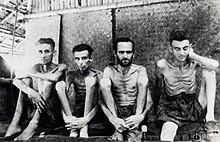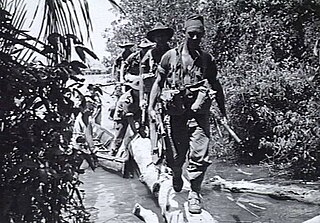Over 27,000 Australians were killed and 23,000 wounded in action during World War II. In addition, hundreds more servicemen and women were killed and injured in accidents during the war.
Contents

Over 27,000 Australians were killed and 23,000 wounded in action during World War II. In addition, hundreds more servicemen and women were killed and injured in accidents during the war.


The following table is taken from The Final Campaigns by Gavin Long. It excludes deaths and illnesses from natural causes, including disease. [1]
| RAN | Army | RAAF | Total | |
| War against Germany, Italy and Vichy France | ||||
| Killed in action | 900 | 2610 | 5036 | 8546 |
| Died of wounds | 3 | 700 | 58 | 761 |
| Died of wounds while POW | 56 | 9 | 65 | |
| Died of sickness or injury while POW | 95 | 95 | ||
| Presumed died while POW | 91 | 14 | 105 | |
| Total killed | 903 | 3552 | 5117 | 9572 |
| POW escaped, recovered or repatriated | 25 | 6874 | 1020 | 7919 |
| Wounded and injured in action (cases) | 26 | 8925 | 529 | 9480 |
| War against Japan | ||||
| Killed in action | 840 | 6294 | 1140 | 8274 |
| Died of wounds | 41 | 1090 | 65 | 1196 |
| Died of wounds while POW | 50 | 50 | ||
| Died of sickness or injury while POW | 5336 | 5336 | ||
| Presumed died while POW | 116 | 2391 | 138 | 2645 |
| Total killed | 997 | 15161 | 1343 | 17501 |
| POW escaped, recovered or repatriated | 238 | 13872 | 235 | 14345 |
| Wounded and injured in action (cases) | 553 | 13191 | 253 | 13997 |
| All theatres of war | ||||
| Killed in action | 1740 | 8904 | 6176 | 16820 |
| Died of wounds | 44 | 1790 | 123 | 1957 |
| Died of wounds while POW | 0 | 106 | 9 | 115 |
| Died of sickness or injury while POW | 0 | 5431 | 0 | 5431 |
| Presumed died while POW | 116 | 2482 | 152 | 2750 |
| Total killed | 1900 | 18713 | 6460 | 27073 |
| POW escaped, recovered or repatriated | 263 | 20746 | 1255 | 22264 |
| Wounded and injured in action (cases) | 579 | 22116 | 782 | 23477 |
The Australian Army suffered 1,165 killed and died of injuries in operational areas and a further 33,396 soldiers were wounded or injured. Casualties in non-operational areas were also significant, with 2,051 soldiers being killed or dying of injuries and 121,800 being wounded or injured. These figures also exclude deaths and illnesses from natural causes. The RAN suffered 177 non-battle casualties and the RAAF 6,271. [2]

The total number of military and civilian casualties in World War I was about 40 million: estimates range from around 15 to 22 million deaths and about 23 million wounded military personnel, ranking it among the deadliest conflicts in human history.

The Italian campaign of World War II, also called the Liberation of Italy following the German occupation in September 1943, consisted of Allied and Axis operations in and around Italy, from 1943 to 1945. The joint Allied Forces Headquarters (AFHQ) was operationally responsible for all Allied land forces in the Mediterranean theatre and it planned and led the invasion of Sicily in July 1943, followed in September by the invasion of the Italian mainland and the campaign in Italy until the surrender of the Axis forces in Italy in May 1945.

The Second Australian Imperial Force was the volunteer expeditionary force of the Australian Army in the Second World War. It was formed following the declaration of war on Nazi Germany, with an initial strength of one infantry division and related auxiliary components. After considerable expansion of this force, three divisions were sent to the Middle East and North Africa, while the 8th Division was sent to garrison British Malaya and Singapore.

Throughout the War in Afghanistan, there had been 3,621 coalition deaths in Afghanistan as part of the coalition operations since the invasion in 2001. In this total, the American figure is for deaths "In and Around Afghanistan" which, as defined by the United States Department of Defense, includes some deaths in Pakistan and Uzbekistan and the deaths of 18 CIA operatives.
The military history of Australia spans the nation's 230-year modern history, from the early Australian frontier wars between Aboriginal people and Europeans to the ongoing conflicts in Iraq and Afghanistan in the early 21st century. Although this history is short when compared to that of many other nations, Australia has been involved in numerous conflicts and wars, and war and military service have been significant influences on Australian society and national identity, including the Anzac spirit. The relationship between war and Australian society has also been shaped by the enduring themes of Australian strategic culture and the unique security challenges it faces.

Estimates of casualties of the Vietnam War vary widely. Estimates can include both civilian and military deaths in North and South Vietnam, Laos, and Cambodia.

The Battle of Tarakan was the first stage in the Borneo campaign of 1945. It began with an amphibious landing by Allied forces on 1 May, code-named Operation Oboe One; the Allied ground forces were drawn mainly from the Australian 26th Brigade, but included a small element of Netherlands East Indies personnel. The main objective of the landing was the capture of the island's airfield. While the battle ended with success for the Allied forces over the Japanese defenders, this victory is generally regarded as having not justified its costs. The airfield was so heavily damaged that it ultimately could not be repaired in time to make it operational for other phases of the Allied campaign in Borneo.
A casualty, as a term in military usage, is a person in military service, combatant or non-combatant, who becomes unavailable for duty due to any of several circumstances, including death, injury, illness, missing, capture or desertion.
During the War in Afghanistan, according to the Costs of War Project the war killed 176,000 people in Afghanistan: 46,319 civilians, 69,095 military and police and at least 52,893 opposition fighters. However, the death toll is possibly higher due to unaccounted deaths by "disease, loss of access to food, water, infrastructure, and/or other indirect consequences of the war." According to the Uppsala Conflict Data Program, the conflict killed 212,191 people. The Cost of War project estimated in 2015 that the number who have died through indirect causes related to the war may be as high as 360,000 additional people based on a ratio of indirect to direct deaths in contemporary conflicts.

The number of Canadian Forces' fatalities resulting from Canadian military activities in Afghanistan is the largest for any single Canadian military mission since the Korean War between 1950 and 1953. A total of 159 Canadian Forces personnel and 7 civilians have died in the conflict.

The General Service Medal, is a campaign medal of the United Kingdom introduced in 1962 to replace both the General Service Medal (1918), as awarded to the Army and RAF, and the Naval General Service Medal (1915). The 1962 GSM was awarded until 2007, when it was replaced by the Operational Service Medal. In 2015 the General Service Medal (2008) was introduced.

The Aitape–Wewak campaign was one of the final campaigns of the Pacific Theatre of World War II. Between November 1944 and the end of the war in August 1945, the Australian 6th Division, with air and naval support, fought the Imperial Japanese 18th Army in northern New Guinea. Considered a "mopping up" operation by the Australians, and although ultimately successful for them with the Japanese forces cleared from the coastal areas and driven inland, amidst difficult jungle conditions, casualties from combat and disease were high. With Japan on the verge of defeat, such casualties later led to the strategic necessity of the campaign being called into question.

The Battle of Slater's Knoll was fought between Australian and Japanese forces on Bougainville Island during the Second World War. Part of the Bougainville campaign, the battle occurred as a force of about 3,300 Japanese from the Japanese 6th Division, including artillery and other supporting elements, launched a counterattack against the main Australian offensive which had been pushing south towards Buin, concentrating their attacks on Slater's Knoll near the Puriata River. The Australian troops belonged to the 7th Brigade, with the 25th Infantry Battalion being the most heavily engaged, although the 9th Infantry Battalion and the 61st Infantry Battalion also took part in the fighting.

The 2/10th Commando Squadron was a commando unit raised by the Australian Army for service in World War II. Raised in 1944, the unit saw action late in the war against the Japanese during the Aitape–Wewak campaign. During this campaign the squadron carried out a number of tasks including long-range patrols, flank protection and area defence. Later in the campaign the 2/10th were used to spearhead an amphibious assault landing at Dove Bay, east of Wewak before being used as line infantry during the final 'mopping up' stages of the campaign. Following the end of the war the unit was disbanded.

The Australian Army was the largest service in the Australian military during World War II. Prior to the outbreak of war the Australian Army was split into the small full-time Permanent Military Forces (PMF) and the larger part-time Militia. Following the outbreak of war on the 3rd of September 1939, 11 days later, on 14 September 1939 Prime Minister Robert Menzies announced that 40,000 members of the Militia would be called up for training and a 20,000-strong expeditionary force, designated the Second Australian Imperial Force, would be formed for overseas service. Meanwhile, conscription was introduced in October 1939 to keep the Militia at strength as its members volunteered for the AIF. The Australian Army subsequently made an important contribution to the Allied campaigns in the Mediterranean, the Middle East and North Africa fighting the Germans, Italians, and Vichy French during 1940 and 1941, and later in the jungles of the South West Pacific Area fighting the Japanese between late 1941 and 1945. Following the Japanese surrender Australian Army units were deployed as occupation forces across the South West Pacific. Meanwhile, the Army contributed troops to the British Commonwealth Occupation Force (BCOF) in Japan from 1946.

The 2/43rd Battalion was an infantry battalion of the Australian Army. Raised in July 1940 in South Australia as part of the 24th Brigade, the battalion was initially part of the 8th Division, until the 24th Brigade was re-allocated to the 9th Division in late 1940. It was with this formation that the 2/43rd saw service in the Middle East in 1941–1942, taking part in the fighting at Tobruk and in the First and Second Battles of El Alamein. It also undertook garrison duties in Syria, before returning to Australia early in 1943 to fight against the Japanese in the Pacific.

The 2/4th Pioneer Battalion was a unit of the Australian Army raised for service during the Second World War. A pioneer unit, the battalion undertook both infantry and engineer tasks. Despite being raised early in the war, the battalion did not see action until the final months, taking part in the Borneo campaign where, as part of the 1st Beach Group, it fought against the Japanese in support of the 9th Division. It was disbanded in early 1946 following the end of hostilities.

Lieutenant Colonel Garth Callender is the author of After the Blast: An Australian Officer in Iraq and Afghanistan, published by Black Inc. in 2015.